Just because I write a food blog one could assume that I know a lot about cooking. And maybe I do, but I don’t put myself on any pedestal about it. I do a lot of reading about cooking, food products, cultural differences about food and herbs and even the more scientific aspect of cooking (because I happen to be intrigued by that part). But let it be known that I have cooking failures. Not frequently, but often enough to make me stop short and re-think what I know about cooking!
 In the last couple of weeks I made a pork dish that was abysmal. I faithfully took photos of it, thinking it would end up here. Uh, no. Awful. Discard those photos. I made a soup one day. It was flavorless. Chuck that recipe in the trash can and dump those photos. I made a cranberry cornmeal pumpkin muffin last week. I had great hopes for that – it was a recipe I found about 15 years ago in a friend’s community cookbook (I love fresh cranberries in things other than sauce). The resulting muffins were just barely okay warm from the oven, but by the next morning they were leaden hockey pucks.
In the last couple of weeks I made a pork dish that was abysmal. I faithfully took photos of it, thinking it would end up here. Uh, no. Awful. Discard those photos. I made a soup one day. It was flavorless. Chuck that recipe in the trash can and dump those photos. I made a cranberry cornmeal pumpkin muffin last week. I had great hopes for that – it was a recipe I found about 15 years ago in a friend’s community cookbook (I love fresh cranberries in things other than sauce). The resulting muffins were just barely okay warm from the oven, but by the next morning they were leaden hockey pucks.
Then I’ll tell you about the breakfast egg dish I made. Meaning I’ll tell you not to make it! It was along the lines of an “impossible pie.” With cheese, asparagus and fresh zucchini in it, I thought it would be lovely. Not.
Would you believe I made a batch of chocolate chip cookies and nearly burned them all. Not so they were inedible, but I sure screwed up that day. My mind must have been somewhere else. I kept forgetting to set the timer!
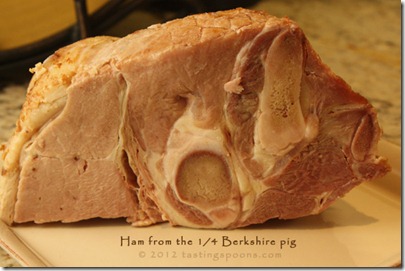 On the positive side of the cooking equation, for Easter dinner we did contribute a nice, big ham from the Berkshire pig we bought last summer. It was raised by a local 4-H kid. We’ve purchased a quarter of a pig before, but decided last year that we really wanted it to be a Berkshire (aka Kurobuta). Our friend Fay, who lets the 4-H kids raise said pigs on her rural property bought the other quarter. Let’s just say the meat has been wonderful!
On the positive side of the cooking equation, for Easter dinner we did contribute a nice, big ham from the Berkshire pig we bought last summer. It was raised by a local 4-H kid. We’ve purchased a quarter of a pig before, but decided last year that we really wanted it to be a Berkshire (aka Kurobuta). Our friend Fay, who lets the 4-H kids raise said pigs on her rural property bought the other quarter. Let’s just say the meat has been wonderful!
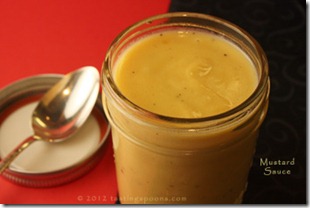 Easter afternoon I made the creamy mustard sauce I’ve made several times. It is just stupendous with ham. It’s mostly cream, uses dry mustard, vinegar and egg yolks. Easy to make, really, and has just the most wonderful flavor, heavy with a vinegar tang.
Easter afternoon I made the creamy mustard sauce I’ve made several times. It is just stupendous with ham. It’s mostly cream, uses dry mustard, vinegar and egg yolks. Easy to make, really, and has just the most wonderful flavor, heavy with a vinegar tang.
We took that to the family dinner. I’m so glad I got some leftovers of the ham (pictured up above) so at least we’ll have a few sandwiches and maybe a pot of lentil soup, or split pea.
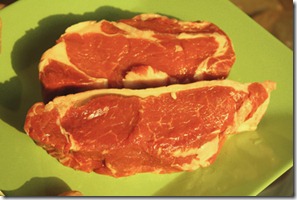 Now, back to the less than perfect meals of late. My DH and I are on a “mission” of sorts these days, about steak. In some soon time frame I’ll be telling you all about it. Dave is just finishing reading a book about it. It has to do with corn fed vs. grass fed beef. So we did a test run last week by buying two different steaks – top one at left is a ribeye (my favorite) – and the lower one is a New York strip (Dave’s preferred cut that day). Both were grass fed here in California. We bought the meat at Whole Foods – the only local place (so far) we’ve found that carries fresh grass-fed beef. The results were lackluster. It could be that the particular producer doesn’t grow the best of grass fed. It may be that we’re just not used to grass-fed taste (it is different – supposed to be more flavorful). For sure the meat was leaner, although looking at the slabs above you’d not know it. There was ample marbling in the ribeye. Not much in the New York. My DH doesn’t mind a tougher chew on a steak. I do, which is why the ribeye was so much better for me. It was tender – very tender, really. It just didn’t have any exploding beefy taste I had expected. We’re not done researching this.
Now, back to the less than perfect meals of late. My DH and I are on a “mission” of sorts these days, about steak. In some soon time frame I’ll be telling you all about it. Dave is just finishing reading a book about it. It has to do with corn fed vs. grass fed beef. So we did a test run last week by buying two different steaks – top one at left is a ribeye (my favorite) – and the lower one is a New York strip (Dave’s preferred cut that day). Both were grass fed here in California. We bought the meat at Whole Foods – the only local place (so far) we’ve found that carries fresh grass-fed beef. The results were lackluster. It could be that the particular producer doesn’t grow the best of grass fed. It may be that we’re just not used to grass-fed taste (it is different – supposed to be more flavorful). For sure the meat was leaner, although looking at the slabs above you’d not know it. There was ample marbling in the ribeye. Not much in the New York. My DH doesn’t mind a tougher chew on a steak. I do, which is why the ribeye was so much better for me. It was tender – very tender, really. It just didn’t have any exploding beefy taste I had expected. We’re not done researching this.
Whole Foods did have several other beef cuts (grass-fed) in the refrigerator case, including some stew beef, so I decided to try that too. Bought 2 pounds. First I went to Eat Your Books and found a recipe I wanted to try from the The Essential New York Times Cookbook: Classic Recipes for a New Century. The one by Amanda Hesser. That I love. But first I must tell you . . . I’m not saying anything disparaging about the recipe. Just me, the cook, the preparer, the screwer-upper. I mean, how difficult can it be to make beef stew? I’ve made stew hundreds of times, just not with this recipe. But I don’t think the recipe was the problem except for maybe one little step. More on that later.
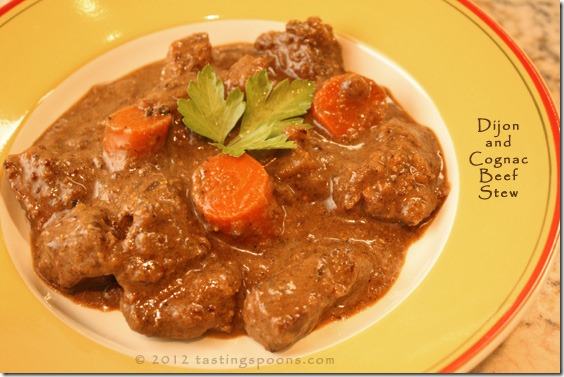 I followed the recipe to a T. After browning or sautéing some onion and shallots in bacon fat, I rolled the beef in some seasoned flour and browned the pieces in the fat left in my big Le Creuset pot. I didn’t crowd the meat (because then it steams rather than browns). The recipe indicated you need to brown the meat really well, to get that delicious fond on the bottom. Okay, I was fine to this point. Then you remove all the meat and start making the liquid that the meat cooks in. First, in goes the brandy – and you’re supposed to be able to scrape up the fond off the bottom. There was ample blackened stuff on the bottom. No problem there, although I couldn’t scrape up much of anything – it was pretty far stuck onto the pan! Next step was to add a copious amount of Dijon mustard (1/2 cup of mustard – that’s a LOT). Then came beef broth and some grainy mustard. Once you add the meat back into the pot you cover it mostly and let it simmer for 90 minutes. I assumed that all that blackened fond would release once the stew simmered awhile with the volume of liquid in the pot. Ahem. Wrong. When I returned in an hour to check on it, nearly ALL the liquid had evaporated and the meat was cooking/burning (obviously at too high a heat) on the bottom of the pot. I think I didn’t turn the burner down to the really low setting when I walked away from it. Oh my. Because the sauce/broth contained a lot of prepared mustard (Dijon, good stuff, not hot dog mustard) as it evaporated it was thicker. Thicker = burn.
I followed the recipe to a T. After browning or sautéing some onion and shallots in bacon fat, I rolled the beef in some seasoned flour and browned the pieces in the fat left in my big Le Creuset pot. I didn’t crowd the meat (because then it steams rather than browns). The recipe indicated you need to brown the meat really well, to get that delicious fond on the bottom. Okay, I was fine to this point. Then you remove all the meat and start making the liquid that the meat cooks in. First, in goes the brandy – and you’re supposed to be able to scrape up the fond off the bottom. There was ample blackened stuff on the bottom. No problem there, although I couldn’t scrape up much of anything – it was pretty far stuck onto the pan! Next step was to add a copious amount of Dijon mustard (1/2 cup of mustard – that’s a LOT). Then came beef broth and some grainy mustard. Once you add the meat back into the pot you cover it mostly and let it simmer for 90 minutes. I assumed that all that blackened fond would release once the stew simmered awhile with the volume of liquid in the pot. Ahem. Wrong. When I returned in an hour to check on it, nearly ALL the liquid had evaporated and the meat was cooking/burning (obviously at too high a heat) on the bottom of the pot. I think I didn’t turn the burner down to the really low setting when I walked away from it. Oh my. Because the sauce/broth contained a lot of prepared mustard (Dijon, good stuff, not hot dog mustard) as it evaporated it was thicker. Thicker = burn.
The stew wasn’t done yet, I knew. An hour and a half of cooking would not be enough to tenderize tough beef cuts. I added in the carrots plus a couple of cups of water and cooked it for another 30 minutes, at which point it was supposed to be done. Uhm. Wrong. Not done. Tough. Dry meat. Awful. I had my DH test a piece. His was barely edible. It was now 7:00 pm and I was impatient. I dragged out my pressure cooker (it lives on a shelf in our laundry room) and poured it all into that, and cooked it for a short time. But then I had difficulty with my pressure cooker. Sigh. It had been awhile since I used it and I wasn’t convinced it was holding pressure correctly. It was spitting steam and water out the edges (gasket problem, perhaps). I brought the pot up to pressure three times in about 20 minutes and each time I sensed a problem. But it was enough to at least get the meat a bit more tender. During the last time I added in the mushrooms so they cooked just enough to eat.
Well – of course, you want to know how it was? I ate about 2 pieces of the beef – it was just too chewy and dry for me. But it was my fault – I’m sure that cooking it at too high a temp during that one hour period just destroyed all the collagen which would be soft and supple if kept just below a simmer! I’ve altered the directions just a bit in the recipe below. The sauce was delicious – and I liked only adding carrots and mushrooms (no potatoes). You also add in a little jot of red wine at the end along with some more of the grainy mustard.
Now, let’s talk about the pot! That blackened stuff on the bottom was still there after all that cooking. I couldn’t scrape it off with a spatula or a stainless steel scraper either. More sighs. I promised my DH that I wouldn’t make him clean the pot (he did offer, but I felt guilty). First I filled it with hot water and simmered that on the stove for about an hour to loosen it, I hoped. Dave did scrape a lot, and using a stainless spatula got a lot more of it off. Then I resorted to using Barkeeper’s Friend and a heavy-duty scrubby pad and got the remainder off. I wasn’t sure my Le Creuset pot would ever recover! Bless it’s little pea-pickin’ heart, it did!
So, all that said, you see, I do have cooking failures. I’ve just had more than usual in the last several weeks. I do hope this isn’t a sign of something . . . but you can make this stew yourself. It has great flavor – just watch the fond and the temperature in the pot.
printer-friendly PDF
MasterCook 5+ import file
Dijon and Cognac Beef Stew
Recipe By: Regina Schrambling, in the New York Times, 2001
Serving Size: 6
NOTES: The little bacon pieces I added back into the stew just before serving. Don’t burn the meat as you’re browning it – do it at medium to avoid a blackened skillet, if necessary. If you burn the bottom, it will add a burned taste to the sauce. I’ve doubled the amount of mushrooms called for. You will probably need more butter with each batch of the beef you brown. My Le Creuset pan required 3 batches.
1/4 pound bacon — or salt pork, diced
1 large onion — finely diced
3 whole shallots — chopped
4 tablespoons unsalted butter — or more as needed
2 pounds beef stew meat — preferably chuck, cut in 1″ pieces
2 tablespoons all-purpose flour
Salt and freshly ground black pepper to taste
1/2 cup brandy — or Cognac
2 cups beef broth
1/2 cup Dijon mustard
1/4 cup whole grain mustard — (divided use)
4 large carrots — peeled, halved lengthwise, cut in half-moons
1 pound mushrooms — stemmed and quartered
1/4 cup dry red wine
1. Place bacon in Dutch oven or other heavy pot over medium-low heat and cook until the fat is rendered. Remove the solid pieces with a slotted spoon and discard. Raise the heat, add onion and shallots and cook until softened but not brown, 10-15 minutes. Use a slotted spoon to transfer to a large bowl.
2. If necessary, add 2 T. butter to the pot to augment the fat and increase heat to medium high. Dust the beef with the flour, salt and pepper. Add half of the meat cubes to the pan and brown on at least 2 sides until meat is well browned, even crusty, then transfer to the bowl. Add more butter to the pan and brown the other half of the meat. Remove the second batch to the bowl.
3. Add the brandy to the pot and cook, stirring, until the bottom is deglazed and the crust comes loose [this didn’t happen for me]. Add the beef broth, Dijon mustard and just 1 T. of the grainy mustard to the pot. Whisk to blend (you don’t want any little clumps of Dijon visible), then return meat and onion mixture to the pot. Lower the heat, partially cover the pot and simmer gently until the meat is very tender, about 1 1/2 hours. [Watch temperature carefully – it should just barely simmer – if liquid evaporates, add water.]
4. Add the carrots and continue simmering for 30 minutes, or until tender.
5. Meanwhile, melt 2 T. butter in a medium skillet over medium-high heat and saute the mushrooms until browned and tender.
6. Stir the mushrooms into the stew, along with the remaining 3 T. grainy mustard and red wine. Simmer for 5 minutes, then taste for seasonings.
Per Serving: 586 Calories; 32g Fat (53.8% calories from fat); 45g Protein; 16g Carbohydrate; 3g Dietary Fiber; 120mg Cholesterol; 1222mg Sodium.





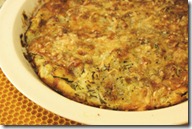

Toffeeapple
said on April 18th, 2012:
I kept having more and more disappointments when I cooked so I stopped doing it other than when absolutely necessary. OH does it all now except when he is away.
Alas, I didn’t marry a man who cooks – except grilling. But he does dishes and laundry, so I will keep him, I think! . . . carolyn t
Kara
said on April 19th, 2012:
I am so glad you are trying grass fed beef. I am sorry though that you have not had a good experience. I only eat grass fed beef these days. Don’t give up just yet. Check out the La Cense Beef website. They have lots of great cooking tips on cooking grass fed beef. There definitely are a few tricks. They also have a wonderful new catalog for you to look at. I buy all of my meat from them and the flavor is amazing! Good luck!
Ah, thank you Kara. I’ll look into it. I’d like to find a good/better source. . . .carolyn t